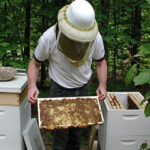While the name George Washington might first bring to mind images of the presidency, pairing it with “Carver” instantly conjures thoughts of peanuts. George Washington Carver, a pioneering agricultural scientist, remarkably developed over 300 diverse products from peanuts. His innovations ranged from practical items like paper and soap to culinary staples such as cooking oil and even milk, showcasing the incredible versatility of this humble legume.
Today, peanuts remain a cornerstone of diets and industries around the globe. In the United States alone, the agricultural sector impressively produced 6.39 billion pounds of peanuts in 2021, according to the U.S. Department of Agriculture. This substantial figure underscores the peanut’s enduring importance in both consumption and commerce.
Have you ever paused to consider where these ubiquitous peanuts actually originate and how they grow? Let’s dig into the fascinating journey of peanuts, from their hidden beginnings to becoming a pantry staple.
Tracing the Geographical Roots of Peanuts
When we ask, “Where Do Peanuts Come From?”, it’s essential to consider global production. China stands as the world’s leading peanut producer, contributing a significant 37% to the global peanut supply. Following China, India is another major player, responsible for 13% of worldwide peanut production. Beyond these giants, several other countries play crucial roles in peanut farming, including Nigeria, Sudan, Senegal, Burma, Guinea, Argentina, and Tanzania. These regions collectively contribute to making peanuts a widely available commodity across the planet.
Interestingly, despite its culinary association with American culture, the United States accounts for only about 5% of the world’s total peanut production, as per USDA data. Within the U.S., peanut cultivation is heavily concentrated in Georgia, which is often called the “peanut state”. However, states like Florida, Alabama, Texas, and North Carolina also significantly contribute to the nation’s peanut harvest. This regional concentration highlights specific climate and soil conditions that are optimal for peanut growth.
The Underground Life Cycle: How Peanuts Grow
Peanuts exhibit a unique growth pattern that sets them apart from tree nuts. They develop beneath the soil, emerging from a plant that initially shows leaves and flowers above ground. This fascinating process, from initial planting to harvest, typically spans four to five months. In the U.S., peanut planting aligns with the warming soil temperatures after the last frost, generally between April and May.
The journey begins with seedlings sprouting and unfurling their leaves approximately ten days post-planting, as reported by the National Peanut Board. Around 40 days later, the plant blossoms with flowers. These flowers are self-pollinating, after which they form a peanut ovary known as the “peg.” Remarkably, the peg’s stem elongates downwards, growing towards the soil, and it’s beneath the soil’s surface where the peanut pods develop and mature. This subterranean growth is a key characteristic that defines peanut farming.
Harvesting peanuts usually occurs from September to October, timed when the soil conditions are neither excessively wet nor arid. Post-harvest, the peanuts undergo a drying process to reduce their moisture content from a high of 25-50% down to a safe storage level of about 10% or less, according to the National Peanut Board. This drying phase is crucial for preventing spoilage and ensuring the peanuts are shelf-stable.
Peanuts: Legumes, Not Nuts
Despite their common culinary categorization alongside nuts, peanuts are scientifically classified as legumes. They belong to the legume family, which also encompasses lentils, peas, beans, chickpeas, soybeans, and various other pod-bearing plants. This classification distinguishes peanuts from true nuts, which are typically hard-shelled fruits of trees.
Understanding that peanuts are legumes provides insights into their nutritional profile and agricultural practices. Legumes are known for their nitrogen-fixing capabilities in the soil and are often rich in protein and fiber, traits shared by peanuts. So, while they might be enjoyed like nuts, their botanical identity firmly places them in the legume family, offering a unique perspective on where peanuts truly come from in the plant kingdom.

